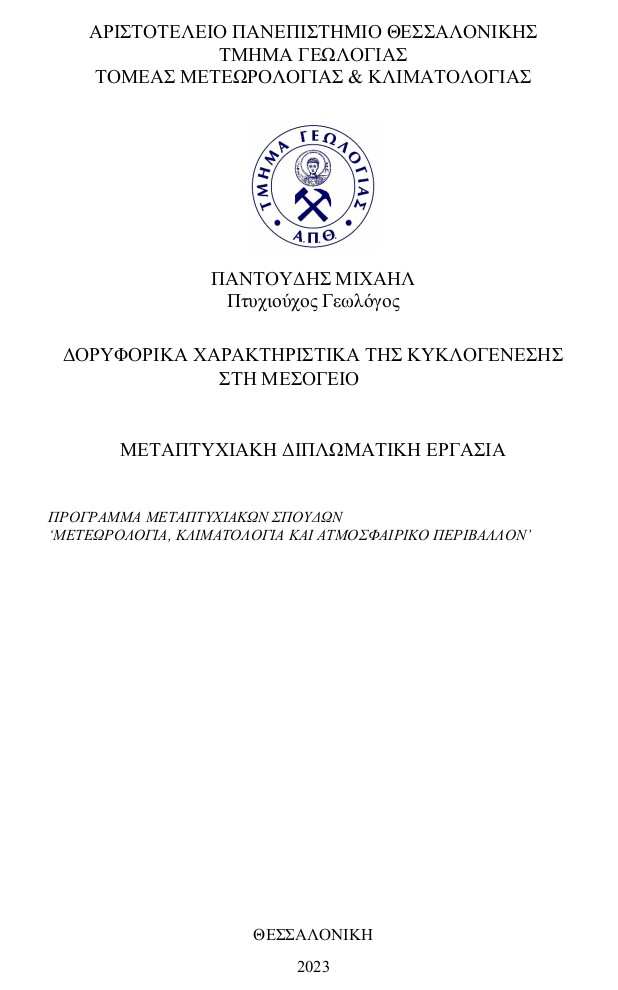
Δορυφορικά χαρακτηριστικά της κυκλογένεσης στη Μεσόγειο = Satellite features of cyclogenesis in the Mediterranean basin.
Περίληψη
Η εξέταση περιλαμβάνει λεπτομερείς αναλύσεις των συνθηκών που οδήγησαν στην ανάπτυξη κάθε κυκλώνα, καθώς και των τροχιών και των ατμοσφαιρικών πιέσεων στην επιφάνεια της θάλασσας. Περιλαμβάνονται επίσης χάρτες επιφανείας και στάθμης 500 hPa για κάθε συμβάν, οι οποίοι απεικονίζουν αποτελεσματικά τα χωρικά χαρακτηριστικά των κυκλώνων. Μέσω αυτής της ανάλυσης, μπορούν να εντοπιστούν κοινά σημεία και αποκλίσεις μεταξύ των 10 φαινομένων, τα οποία μπορούν να βοηθήσουν στη βελτίωση της κατανόησης της δυναμικής της κυκλογένεσης με βάση τη χρονική διάρκεια, τα δομικά χαρακτηριστικά και τα φασματικά χαρακτηριστικά.
Τα αποτελέσματα αυτής της μελέτης έχουν τη δυνατότητα να βελτιώσουν την κατανόηση και τη διαχείριση των επιπτώσεων αυτών των μετεωρολογικών φαινομένων. Παρέχοντας μια πιο λεπτομερή κατανόηση των χαρακτηριστικών αυτών των κυκλώνων, μπορεί να βελτιωθεί η ικανότητα πρόβλεψης και παρακολούθησης τους, γεγονός που μπορεί να βοηθήσει στη μείωση των επιπτώσεων στις παράκτιες περιοχές. Επιπλέον, αυτή η έρευνα μπορεί επίσης να βοηθήσει στην κατανόηση των καιρικών μοτίβων και του ρόλου αυτών των κυκλώνων στη διαμόρφωση του κλίματος.
Συνοπτικά, αυτή η μελέτη παρέχει μια πολύτιμη συμβολή στο υπάρχον κομμάτι έρευνας για την κυκλογένεση και τα αποτελέσματά της μπορούν να χρησιμοποιηθούν για την καλύτερη κατανόησης αυτών των μετεωρολογικών φαινομένων και των επιπτώσεων που υφίστανται στην περιοχή.
This study analyzes the characteristics of cyclogenesis using satellite imagery from January to December 2021. The study focuses on 10 events that occurred during this period and categorizes them based on their spectral characteristics, shapes, and forms. By utilizing various satellite channels, including visible 0.8 μm, infrared 10.8 μm, enhanced infrared, RGB Airmass, RGB 24hour Microphysics, RGB Day Microphysics, and water vapor 6.2 μm, a comprehensive understanding of the dynamics and characteristics of these meteorological phenomena is provided.
The examination includes detailed analyses of the conditions that led to the development of each cyclone, as well as their trajectories and sea surface atmospheric pressures. Sea surface maps and 500 hPa surface are also included for each event, which effectively illustrate the spatial characteristics of the cyclones. Through this analysis, commonalities, and disparities among the 10 events can be identified, which can aid in improving the understanding of the dynamics of cyclogenesis, based on duration, structural features, and spectral characteristics.
The results of this study have the potential to enhance the understanding and management of the impacts of these meteorological phenomena. By providing a more detailed understanding of the characteristics of these cyclones, the ability to forecast and track them can be improved, which can help to reduce the impacts on coastal regions. Furthermore, this research can also aid in comprehending the weather patterns and the role of these cyclones in shaping the climate.
In summary, this study provides a valuable contribution to the existing body of research on cyclogenesis, and its results can be used to enhance the understanding of these meteorological phenomena and the impacts they have on the region.
Πλήρες Κείμενο:
PDFΑναφορές
Buzzi A. · Tibaldi S., 1978. Cyclogenesis in the lee of the Alps: a case study. Quart. J.Roy. Meteor. Soc 10, 271 – 288.
Čampa J. · Wernli, H., 2012.: A PV Perspective on the Vertical Structure of Mature Midlatitude Cyclones in the Northern Hemisphere, J. Atmos. Sci., 69, 725–740.
Emanuel K., 2005: Genesis and maintenance of “Mediterranean hurricanes”, Adv. Geosci., 2, 217–220.
Fita L. · Romero, R. · Ramis C., 2006.: Intercomparison of intense cyclogenesis events over the Mediterranean basin based on baroclinic and diabatic influences, Adv. Geosci., 7, 333–342.
Flaounas E. · Kotroni V. · Lagouvardos K. · Flaounas I., 2014.: CycloTRACK (v1.0) – tracking winter extratropical cyclones based on relative vorticity: sensitivity to data filtering and other relevant parameters, Geosci. Model Dev., 7, 1841–1853.
Flaounas E. · Kelemen F. D. · Wernli H. · Gaertner M. A. · Reale M. · Sanchez-Gomez E. · Lionello P. · Calmanti S. · Podrascanin Z. · Somot S. · Akhtar N. · Romera R. · Conte D., 2018a.: Assessment of an ensemble of ocean–atmosphere coupled and uncoupled regional climate models to reproduce the climatology of Mediterranean cyclones, Clim. Dynam., 51, 1023–1040.
Flaounas E. · Kotroni V. · Lagouvardos K. · Gray S. L. · Rysman J.-F. · Claud C., 2018b.: Heavy rainfall in Mediterranean cyclones. Part I: contribution of deep convection and warm conveyor belt, Clim. Dynam., 50, 2935–2949.
Galanaki E. · Flaounas E. · Kotroni V. · Lagouvardos K. · Argiriou A., 2016: Lightning activity in the Mediterranean: quantification of cyclones contribution and relation to their intensity: Mediterranean cyclones associated with lightning activity, Atmos. Sci. Lett., 17, 510–516.
Kouroutzoglou J. · Flocas H. A. · Keay K. · Simmonds I. · Hatzaki M., 2011: Climatological aspects of explosive cyclones in the Mediterranean, Int. J. Climatol., 31, 1785–1802.
Lionello P. · DalanF. · Elvini E., 2002 Cyclones in the Mediterranean region: the present and the doubled CO2 climate scenarios. Clim. Res; 22: 147–159.
Mayengon R., 1984.: Warm core cyclones in the Mediterranean. Mariners Weather Log, 28: 6– 9.
Miglietta, M. M. · Rotunno R., 2019.: Development mechanisms for Mediterranean tropical-like cyclones (medicanes), Q. J. Roy. Meteorol. Soc., 145, 1444–1460.
Petterssen S., 1956.: Weather analysis and forecasting. McGraw-Hill, New York.
Pytharoulis I. · George C Craig · Susan P Ballard, 2000.: The hurricane-like Mediterranean cyclone of January. 1995 Department of Meteorology, University of Reading, 277.
TrigoI. F., 2006.: Climatology and interannual variability of storm tracks in the Euro-Atlantic sector: a comparison between ERA-40 and NCEP/NCAR reanalyses. Clim. Dyn.; 26: 127–143.
TrigoI. F. · DaviesT. D. · BiggG. R., 1999.: Objective climatology of cyclones in the Mediterranean region. J. Clim.; 12: 1685–1696.
Διαδικτυακές Πηγές
https://www.metoffice.gov.uk
https://eumetrain.org/
https://www.nesdis.noaa.gov/
https://www.eumetsat.int/
https://nomads.ncep.noaa.gov/
Εισερχόμενη Αναφορά
- Δεν υπάρχουν προς το παρόν εισερχόμενες αναφορές.
